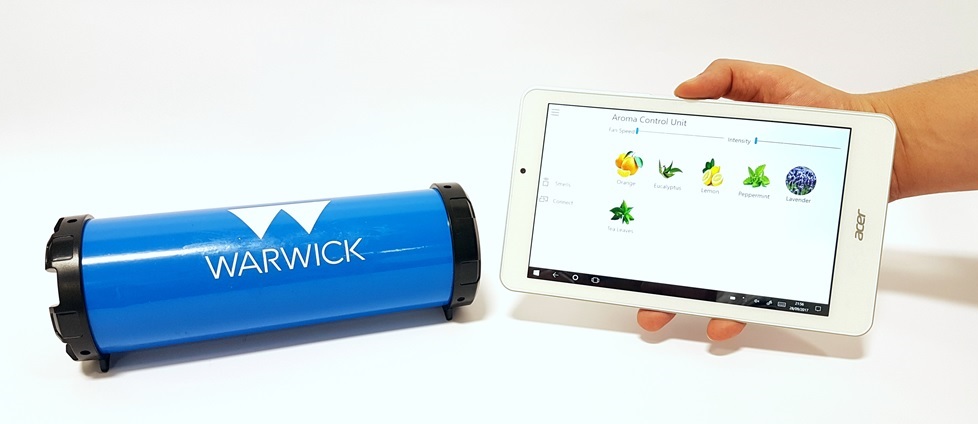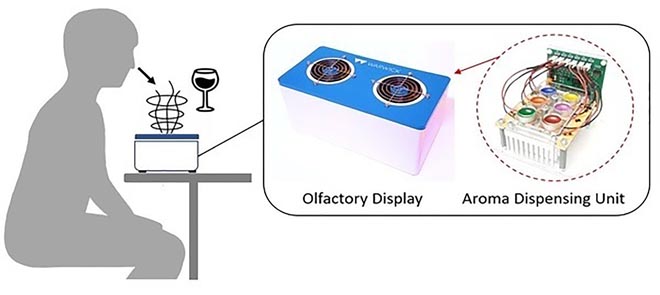WOLF-Aroma
The field of olfaction has remained one of the most underdeveloped technological areas in our modern digital world. Though there have been significant advances in the way that information is presented to us as digital users – be it through visual or audio means, olfaction still appears to be a technology of the future. The reasons for this are complex and potentially associated with a mixture of factors, including the dominance of our other senses, poor training of the population in olfaction and a feeling that it is not an important sense. However, olfaction has the ability to enrich visuals and provide easier access to parts of our brain associated with, for example, long term memory.
The potential applications for olfactory technology are significant and range from medical applications to virtual reality (VR). This could include helping with anxiety/stress or in the diagnosis of degenerative disorders such as Parkinson’s disease. In tourism/museum environments, smells can be used to compliment sound and vision effects of historical sites to re-live the past. Other applications include VR and multimedia to enhance gaming, television entertainment and beyond.
Considering these applications, it is surprising that olfactory displays are not common throughout society and found in every home. There are a number of potential reasons for this, but one major gap is the lack of a simple, robust digital olfactory technology. These technologies should not be confused with most existing aroma approaches, such as air fresheners, perfumes (with paper smelling strips) or even candles, but are distinct in being able to provide a range of olfactory experiences controlled in a digital way.
Unsurprisingly, there have been a number of attempts to produce such digital olfactory displays. The first works were associated with the addition of aromas in cinemas (so-called AromaRama) in the 1960s, which sprayed perfume from seats in an auditorium. At the same time, Morton Heilig brought out the Sensorama – the first full VR system. Neither of these products were a success and olfactory displays were limited to scratch cards till the late 1990s. Though there have been many further attempts, commercial success remains challenging.
Due to the lack of commercially available technologies, our group has attempted to develop simple olfactory displays that other groups could construct and use for their own needs. Below shows two examples of such devices.
I. Liquid based Olfactory Display
Our group have previously published two olfactory display units, both based on a thermal release mechanism. Our first device, was based on the heating of essential oils to produce a cloud of aroma, which is subsequently pushed out of the unit with a fan. The heating element is platinum wire which is coiled inside a capillary tube, placed inside a glass vial. This was fully computer controlled via a portable device (such as a tablet) wirelessly. The unit can be loaded with 8 different aromas, which can be used multiple times. The completed unit was the size of a Bluetooth speaker. A photo of the unit is show below.

First Generation Olfactory Display
II. Wax based Olfactory Display
A more recent is olfactory display, using Peltier heating elements and wax as the aroma carrier. The unit is fully computer-controlled and holds up to 12 ‘aroma capsules’. Each capsule contains an individual aroma that can either be activated on its own or with others to create richer experiences. The unit is larger that our original device and is the size of a larger Bluetooth speaker. The unit was designed as part of a wine aroma game to promote sensory training. The portable device has been tested with 15 volunteers to test the detection and recognition times of 6 aromas associated with red or white wines. An overview of the unit is shown below.

Second Generation Olfactory Display
III. Future Olfactory Displays
We are now working on our next generation of olfactory displays, these will be shown here once published. We are also looking into a range of applications for our units. For more information on out Olfactory Displays, please contact Prof James Covington.
